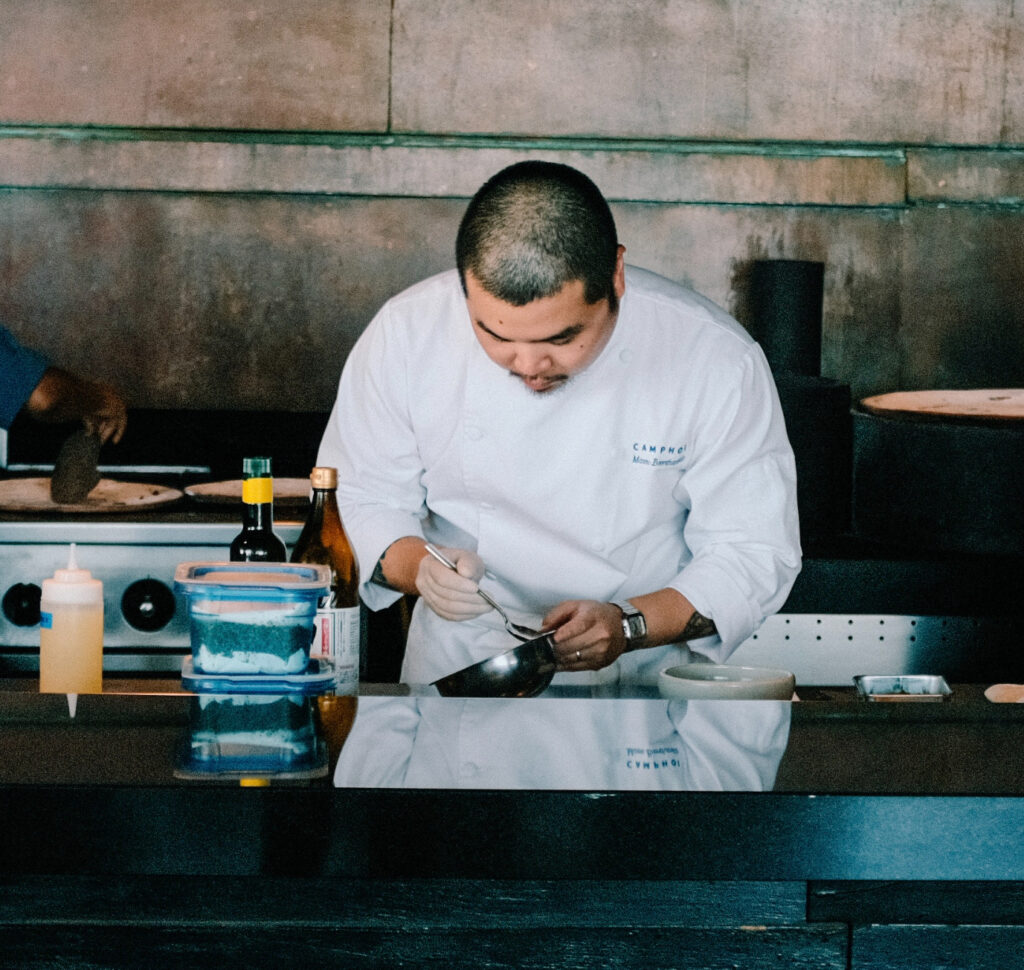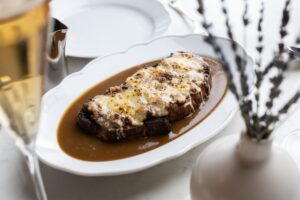




Tucked into the heart of Los Angeles’ Arts District—where industry meets inspiration and old warehouses quietly evolve into spaces of cultural significance—Camphor presents itself not with bluster, but with clarity. It does not shout to be noticed. Rather, it invites, seduces, and ultimately earns admiration through thoughtful execution. Within less than a year of its opening, Camphor was awarded a Michelin star, not through novelty or excess, but by practicing restraint: the elevation of French classics via contemporary technique, reimagined for the modern gourmand.
Here, ingredients are not overwhelmed with ego, nor drowned in overwrought flair. Instead, Camphor distills the essence of French gastronomy—its precision, its reverence for technique, its romance—and fuses it with a Californian mindset: local sensibility, elegant minimalism, and a quiet boldness. The result is a menu where every dish speaks a dialect of its origin but resonates globally.
A Philosophy of Precision and Reverence
At Camphor, the name is no coincidence. Camphor—an organic compound derived from the wood of the camphor laurel tree—is aromatic, restorative, and historically used in both medicine and ritual. It invokes the old world while offering fresh breath. This duality runs through every course the restaurant offers: a tension between memory and invention, tradition and experimentation.
From the moment one enters, the dining space confirms this ethos. The interior avoids cliché French brasserie trappings and instead opts for a minimalist geometry—a mood more Paris Left Bank than Champs-Élysées. Clean lines, moody lighting, and polished materials draw the focus where it belongs: to the table.
Le Burger: A Study in Indulgent Restraint
If there is a singular item on the Camphor menu that encapsulates its culinary identity, it is Le Burger. On paper, it reads decadent—a duck and sirloin patty, nestled into a duck-fat brioche bun, and finished with smoked Gouda. Yet in execution, it avoids excess.
The duck lends a buttery depth, a subtle gaminess that the beef’s structure and marbling temper. The Gouda, not just smoky but elegantly melted into a cohesive layer, does not intrude—it envelops. The duck-fat brioche, golden and glistening, has a crisp exterior and a yielding, almost custard-like interior crumb.
Each bite is orchestrated: sweet, fatty, tender, crisp, and rich—but never heavy. The acidity from the garnish, the restrained use of sauce, and the patty’s seasoning show the chef’s discipline. This is not street food masquerading as fine dining. This is a bistro classic reinterpreted as a masterwork, rightly named one of Los Angeles’ finest burgers.
The Onion Tartine: Deconstruction and Devotion
For the diner drawn to innovation with emotional undercurrent, the Onion Tartine is the standout. Not a tartine in the conventional sense, and not quite French onion soup, the dish is a reconstruction—or rather, a translation—of the latter.
The onions are confit, their sugars coaxed out slowly, developing richness and depth. The Gruyère, melted and torched, adheres to toasted slices of housemade bread. But what elevates it is its architectural layout: the toast acts as both foundation and conduit. A consommé reduction—potent, concentrated, and glossy—may appear beneath or around the plate’s edges, hinting at the soul of the original soup.
Here, Camphor channels memory through technique: each flavor of the traditional dish is present, but the texture, the delivery, and the pacing are transformed. In essence, it is a love letter to a classic, written in a modern hand.
Ribeye and Ritual: A Carnivore’s Epiphany
Camphor’s Ribeye is not simply a steak—it is a moment. Aged precisely, seared with the kind of confidence born from repetition, and rested patiently, the cut arrives with a charred edge that suggests flame and smoke. Internally, it glows in gradients of pink and ruby.
But what distinguishes it is the clarity of the fat, which melts as though it were a finishing oil. Each slice offers a bite that is not just about beef, but about texture and depth—a mouthfeel that straddles robustness and grace.
Accompanied by simple jus or Béarnaise (subject to seasonal changes), the Ribeye speaks in whispers, not declarations. It doesn’t rely on flamboyant garnishes but rather lets the integrity of the animal, the precision of the fire, and the focus of the chef do the speaking.
Sweet Alchemy: Bread Pudding Reinvented
Desserts at Camphor do not merely close a meal—they encapsulate its philosophy. The Bread Pudding, often a comfort dish relegated to rustic tables, becomes an act of culinary elevation.
Made from laminated pastry rather than stale loaf, the pudding is laced with notes of brown butter, vanilla bean, and perhaps a touch of Calvados. Its interior is custardy, its edges caramelized and layered. The accompanying crème anglaise is poured tableside, warm and silk-like, perfuming the plate and softening the crisp.
This is not a dish that clings to nostalgia. It reaches forward, transforming humble ingredients through technique, fire, and finesse.
Camphor’s Cocktail Canon: Parisian Vignettes in a Glass
Where the food leans into quiet confidence, the cocktail program dares to be more architectural, theatrical, and cerebral. Each drink is a conceptual homage to a Parisian landmark or neighborhood, and the presentation is as deliberate as the pour.
One might sip a “Trocadéro”, combining Armagnac, absinthe mist, and herbal vermouth, garnished with a candied herb leaf. Or the “Montmartre Affair”, a clarified milk punch infused with black tea, fig, and lemon balm—elegant, spectral, and strong.
There’s a cocktail here for every form of Francophilia, each created with the same discipline and delicacy as the dishes on the plate. The glassware? Weighted and slender. The garnish? Intentional and never excessive. This is a cocktail menu as topography, one that guides you through a liquid map of Paris without ever leaving Los Angeles.
Service, Space, and the Ritual of Arrival
Camphor does not overwhelm the senses. Instead, it teaches the diner how to listen with the palate. The service is informed but never didactic, the kind that knows when to disappear and when to describe a preparation like a verse of poetry.
The dining room—dim, monolithic, intimate—feels curated yet unpretentious. Tableware is elegant and tactile. Plates are framed, not decorated. Every object has purpose; every placement has thought.
The flow of the meal is paced like a sonata. No course lingers too long. No transition feels rushed. This is where culinary choreography meets hospitality design.
The Star That Shone Swiftly
That Camphor earned a Michelin star within a year is not surprising. What’s remarkable is how quietly they did it. There was no fireworks marketing campaign, no reliance on celebrity presence or social media sensationalism.
Instead, the star came because of what Michelin reveres most: consistency, technique, purpose, and soul. Camphor succeeded by trusting in its kitchen’s integrity, in the narrative of its menu, and in the refinement of its craft.
It is a rare thing: a restaurant that wears its star not as armor, but as an accent.
Flow
To dine at Camphor is to experience a kind of alchemy—a transformation of the expected into the exceptional. Like its namesake, the restaurant has an aromatic clarity, a medicinal beauty. It heals without preaching. It invigorates without shouting.
In a city saturated with culinary reinventions and loud plate theatrics, Camphor finds success through subtle architecture, discipline, and flavor as memory. Every dish, every sip, every gesture—rooted in France, reimagined in California, delivered with Japanese-like restraint—reminds us what it means to care deeply about food.
It is not a place to go for spectacle.
It is a place to remember how good taste feels.
No comments yet.








